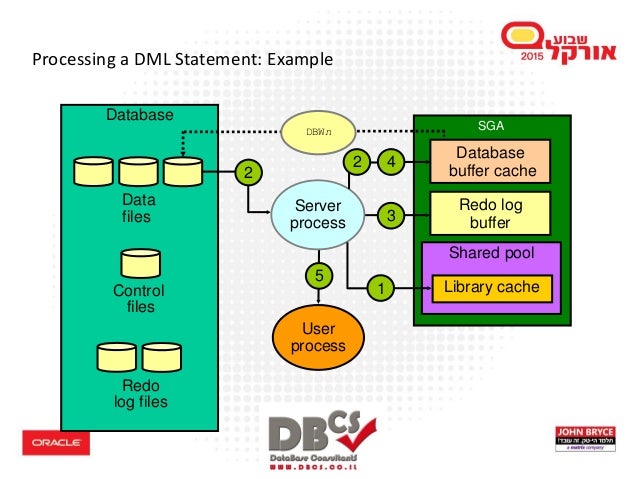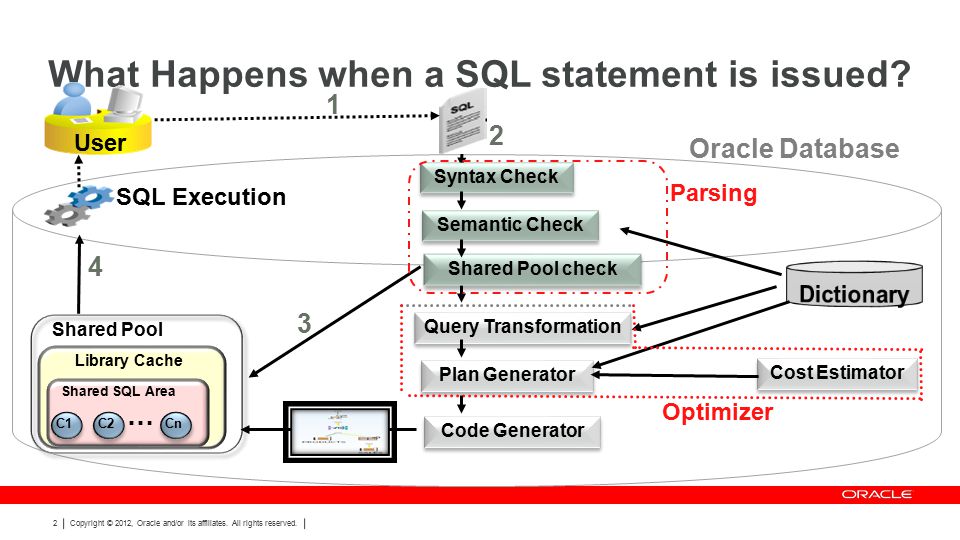Common Abbreviations
-
Global
SGA: System Global Area
PGA: Program Global Area -
Database Language
DML: data manipulation language (insert, delete, update, select)
DDL: data definition language (create, alter, drop, truncate) – TABLE level
DCL: data control language (grant, deny, revoke) – Permission -
Database Process
DBWn: Database Block Writer
CKPT: Checkpoint Process
LGWR: Log Writer
SCN: System Change Number -
Communication Protocol
BGP: Border Gateway Protocol
Structure

- Connection
- Connection: Bidirectional network pathway between a user process on a client or mid tier and an Oracle process on the server.
- Session: Representation of a specific login by a user.
- Program Global Area
- PGA (Program Global Area) is a memory area that contains:
- Session information
- Cursor information
- SQL execution work areas:
- Sort area
- Hash join area
- Bitmap merge area
- Bitmap create area
- Work area size influences SQL performance
- Work areas can be automatically or manually managed
- PGA (Program Global Area) is a memory area that contains:
- System Global Area
- Database Buffer Cache
- Holds copies of data blocks that are read from data files
- Is shared by all concurrent processes
- Redo Log Buffer
- Is a circular buffer in the SGA (based on the number of CPUs)
- Contains redo entries that have the info to redo changes made by operations, such as DML and DDL
- Shared Pool
- Library Cache
- Shared parts of SQL and PL/SQL statements
- Data dictionary Cache
- Result Cache
- SQL queries
- PL/SQL functions
- Control structures
- Locks
- Library Cache
- Large Pool
- Provides large memory allocations for:
- Sessions memory for the shared server and Oracle XA interface
- Parallel execution buffers
- I/O server processes
- Oracle Database backup and restore operations
- Optional pool better suited when using the following:
- Parallel execution
- Recovery Manager
- Shared server
- Provides large memory allocations for:
- Java Pool and Streams Pool
- Java pool memory is used in server memory for all session-specific Java code and data in the JVM
- Streams pool memory is used exclusively by Oracle Streams to:
- Store buffered queue messages
- Provide memory for Oracle Streams Processes
- Database Buffer Cache
Processing Flow – Architecture Level

Example and Explaination:
ORACLE SQL execution flow:
sqlplus usr/passwd@server
SQL>select * from emp;
SQL>update emp set salary=30000 where empid=10;
SQL>commit;
So we will understand what is happening internaly:
Once we hit sqlplus statement as above client process(user) access sqlnet listener.
Sql net listener confirms that DB is open for buisness and create server process.
Server process allocates PGA. ‘Connected’ Message returned to user.
SQL>select * from emp;
Server process checks the SGA to see if data is already in buffer cache.
If not then data is retrived from disk and copied into SGA (DB Cache).
Data is returned to user via PGA and server process.
Now another statement is:
SQL>Update emp set salary=30000 where empid=10;
Server process (Via PGA) checks SGA to see if data is already there in buffer cache.
In our situation chances are the data is still in the SGA (DB Cache).
Data updated in DB cache and mark as Dirty Buffer.
Update employee placed into redo buffer.
Row updated message returned to user.
SQL>commit;
Newest SCN obtained from control file.
Data in DB cache is marked as Updated and ready for saving.
commit palced into redo buffer.
LGWR writes redo buffer contents to redo log files and remove from redo buffer.
Control file is updated with new SCN.
Commit complete message return to user.
Update emp table in datafile and update header of datafile with latest SCN.
SQL>exit;
Unsaved changes are rolled back.
Server process deallocates PGA.
Server process terminates.
After some period of time redo log are archived by ARCH process.
Processing Flow – Logic Level

